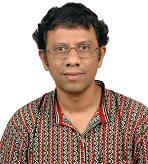Recent Colloquium
Colloquium # 266
Down-To-Earth String Theory
by Prof. Rajesh Gopakumar
International Centre for Theoretical Sciences-TIFR,
Bangalore
Tuesday, November 29th at 3:30 PM, Seminar Hall

Abstract
String theory has evolved into a powerful framework which is capable of providing fresh insights into well established frameworks like quantum field theory (QFT). One such set of new perspectives have been on conformal field theories (CFTs) which are central to our understanding of QFTs. This talk will be centred on some very "down-to-earth CFTs" such as the Wilson-Fisher fixed point (and its analogues and generalisations) that governs critical phenomena in statistical mechanics. We will aim to bring out the utility as well as beauty of the new angles that string theory methods bring to these well studied systems.
About the speaker
Rajesh Gopakumar is a theoretical physicist at the International Centre for Theoretical Sciences-TIFR, Bangalore. Gopakumar's work has been on topics in Quantum Field Theory and String Theory, particularly at the interface of these two subjects. Quantum Field Theory is the framework that best captures interactions in nature from the subatomic scale to the tabletop. String theory aims to generalise this framework to also encompass gravity and thus understand the mysteries of the big bang as well as black holes. A striking relation, known often as “gauge-string duality”, between the two subjects suggests a hidden “holographic” facet to gravitational theories as well as unsuspected regularities in the behaviour of quantum field theories of strongly interacting systems. This relation known often as “gauge-string duality” has led to string theory interfacing with hitherto distant seeming subjects like the physics of the quarkgluon plasma as well as condensed matter systems.
The primary aim of Gopakumar’s research has been to elucidate the extent of this relationship in terms of its scope and its ramifications. He has put forward a program to derive this duality from first principles. As part of this venture he has also extended our knowledge of gauge-string duality by the discovery of new fruitful examples of this connection. In this context, his work with Cumrun Vafa on topological strings led to what is now known as Gopakumar-Vafa duality. This work also led to a novel spinoff in mathematics in defining a new class of enumerative invariants in algebraic geometry -the Gopakumar-Vafa invariants. His recent work with Matthias Gaberdiel revealed a new aspect to the well studied conformal field theories in two dimensions (which are widely applied, for instance, in the study of critical phenomena in statistical mechanics) in exhibiting a duality with theories of higher spin fields in three dimensions.
Gopakumar did his undergraduate studies in physics at the Indian Institute for Technology at Kanpur. He then went on to do his doctoral work at Princeton University. He received his Ph.d. in 1997 under the supervision of Prof. David Gross (Nobel Laureate, Physics 2004). After a few years as research associate at Harvard University, he joined HRI in 2001. He also held a visiting membership at the Institute for Advanced Study, Princeton from 2001-2004.
He is the recipient of the 2004 B. M. Birla Science Prize, the 2006 ICTP Prize (given by the Abdus Salam International Centre for Theoretical Physics, Trieste) and the 2006 Swarnajayanthi Fellowship as well as the 2015 JC Bose Fellowship of the DST. He is the recipient of the Shanti Swarup Bhatnagar award in the physical sciences for 2009 - the highest scientific award for science in India. He received the 2013 TWAS award in the physical sciences and ad 2013 GD Birla Award for scientific research. He was also elected a member of the Indian Academy of Sciences (IAS) in 2008, the Indian National Science Academy (INSA) in 2009, the National Academy of Sciences, India (NASI) in 2014 and of the The World Academy of Sciences (TWAS) in 2015. He is also a founding member (now alumnus) of the Global Young Academy (GYA).

